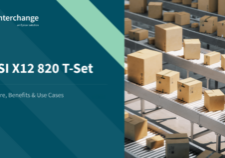ANSI X12 EDI 846 T-Set: Structure, Benefits & Use Cases
Electronic Data Interchange (EDI) has served as the backbone for digital communications in multiple industries for decades now.
But many businesses are still grappling with understanding how it can be used to better their supply chain management. That’s why we’ve put together a series of explainers on the most valuable EDI standards and transaction sets (T-Sets) that businesses should understand.
Today we’ll be exploring the ANSI X12 EDI 846 T-Set. This transaction set is crucial for businesses seeking real-time inventory data, enabling better decision-making and efficient supply chain operations.
Keep reading to find out more about what makes this T-Set so useful and how you can utilise its benefits in your organisation.
Suggested reading: Check out our in-depth explainer on the ANSI X12 standard to get started.
What is the ANSI X12 EDI 846 T-Set?
The ANSI X12 EDI 846 T-Set is a standardised electronic document used by businesses to communicate information about their inventory levels.
Part of the ANSI X12 EDI standards developed by the American National Standards Institute, this transaction set facilitates the exchange of information concerning the quantity and status of goods in stock; it allows companies to query or inform others about inventory levels, providing updates that reflect current quantities, conditions, or locations of products.
By using the EDI 846, companies can automate the reporting of inventory status, reduce manual workloads, and ensure more accurate and timely information exchange. Whether it’s a manufacturer checking on component availability at a supplier or a retailer ensuring that stock levels are adequate to meet consumer demand, the EDI 846 is an essential tool in the arsenal of modern inventory management.
Common use cases for the ANSI X12 EDI 846 T-Set
The versatility of the ANSI X12 EDI 846 T-Set makes it valuable across various industries, particularly those that depend on precise inventory management. Here are some of the common use cases:
- Retail: In retail, the EDI 846 is used to manage and report inventory levels across multiple locations. It helps retail outlets keep adequate stock, particularly during peak shopping seasons or promotions, facilitating swift restocking and reducing the risk of stockouts.
- E-commerce: For e-commerce platforms, maintaining accurate and real-time inventory data is crucial to prevent overselling and ensure customer satisfaction. The EDI 846 helps online retailers keep track of stock levels, update their e-commerce systems automatically, and manage customer expectations accurately regarding product availability.
- Manufacturing: Manufacturers rely on the EDI 846 to monitor parts and materials availability from suppliers. This ensures continuous production cycles and helps in planning and executing manufacturing schedules without unexpected delays due to inventory shortages.
- Healthcare: In the healthcare industry, the EDI 846 is used to track medical supplies, devices, and medications. It ensures that hospitals and clinics maintain an adequate supply of necessary medical items, which is crucial for patient care and operational efficiency.
By integrating the EDI 846 into their operational frameworks, organisations in these sectors can enhance their inventory visibility and management, which is critical for optimising operations and improving service delivery.
Benefits of implementing the ANSI X12 EDI 846 T-Set
Adopting the ANSI X12 EDI 846 T-Set offers numerous advantages that can significantly impact a business’s operational efficacy. Here are some key benefits:
- Better inventory management: With real-time data on inventory levels, companies can reduce the incidence of overstocking or stockouts, leading to more efficient inventory handling and cost savings.
- Operational efficiency: Automating inventory data exchange reduces the need for manual checks and communication, speeding up related processes and reducing errors. This leads to smoother operations and enhanced productivity.
- Supply chain coordination: The EDI 846 improves coordination among supply chain partners by providing timely and accurate inventory data, facilitating better planning and response strategies across the supply chain.
- Cost reduction: By minimising manual labour and reducing errors, businesses can lower operational costs. Automated inventory reports also reduce the need for physical inventories and related expenses.
- Customer satisfaction: Accurate inventory data helps businesses manage customer expectations better, ensuring that product availability aligns with what is communicated to customers, thus enhancing overall customer satisfaction.
Example of an ANSI X12 EDI 846 T-Set
To provide a clearer understanding, here’s an example of what an ANSI X12 EDI 846 T-Set might look like:
| ST*846*0001~ BIA*00*IN*20240430*123456~ DTM*007*20240501~ N1*SE*Supplier Name*92*12345~ LIN*01**VP*123-ABC-001~ QTY*33*100*EA~ CTP**PUR*10.00*EA*100*PE~ LIN*02**VP*123-ABC-002~ QTY*33*200*EA~ CTP**PUR*15.00*EA*200*PE~ CTT*2~SE*12*0001~ |
Here’s an explanation of what each of the different segments mean and represent:
| Segment | Example | Description |
| ST | ST*846*0001~ | Transaction Set Header: Indicates the start of a transaction set (846 for Inventory Inquiry/Advice) and includes a control number for reference. |
| BIA | BIA*00*IN*20240430*123456~ | Beginning Segment for Inventory Inquiry/Advice: Provides information such as transaction set purpose, transaction set identifier, date, and transaction reference number. |
| DTM | DTM*007*20240501~ | Date/Time Reference: Specifies relevant dates/times for the transaction, such as the date when the inventory information was reported. |
| N1 | N1*SE*Supplier Name*92*12345~ | Name: Identifies a party by role (SE for Supplier), name, and an identification code. |
| LIN | LIN*01**VP*123-ABC-001~ | Item Identification: Identifies the item being reported on. |
| QTY | QTY*33*100*EA~ | Quantity: Details the quantity of the item in stock, specifying the quantity (100) and the unit of measure (EA for each). |
| CTP | CTP**PUR*10.00*EA*100*PE~ | Pricing Information: Provides pricing or cost data related to the items, including price per unit and terms. |
| LIN | LIN*02**VP*123-ABC-002~ | Item Identification: Identifies another item being reported on. |
| QTY | QTY*33*200*EA~ | Quantity: Details the quantity of another item in stock, specifying the quantity (200) and the unit of measure (EA for each). |
| CTP | CTP**PUR*15.00*EA*200*PE~ | Pricing Information: Provides additional pricing or cost data for another item. |
| CTT | CTT*2~ | Transaction Totals: Indicates the total number of line items in the transaction. |
| SE | SE*12*0001~ | Transaction Set Trailer: Ends the transaction set and includes the total number of segments included (12) and matches the control number in the ST segment. |
How is the ANSI X12 EDI 846 T-Set processed?
The processing of the ANSI X12 EDI 846 T-Set involves several steps, from data collection to the dissemination of information to relevant parties. Below is a detailed breakdown of the typical workflow:
- Data collection: Initially, the entity managing inventory (like a warehouse or supplier) gathers and updates inventory data in their systems.
- EDI 846 preparation: This updated inventory data is then formatted into an EDI 846 document according to the ANSI X12 standards.
- Transmission: Once prepared, the EDI 846 is sent to the intended recipient(s) such as retailers, wholesalers, or other trading partners using secure EDI transmission protocols.
- Receipt and integration: Upon receiving the EDI 846, the recipient’s system processes the data. This typically involves integrating the inventory data into their internal systems such as ERP or inventory management systems.
- Action and response: Based on the updated inventory information, the recipient can make informed decisions such as placing orders, adjusting sales strategies, or updating further supply chain planning.
- Confirmation: In some cases, a confirmation or functional acknowledgment (like an EDI 997) is sent back to the sender, confirming the receipt and processing of the inventory data.
What are the equivalents of the ANSI X12 EDI 846 T-Set in other standards?
The ANSI X12 EDI 846 Transaction Set has equivalents in various other electronic data interchange (EDI) standards, which serve similar purposes in different regions or industries. Understanding these equivalents is crucial for businesses operating internationally or with partners using different EDI standards.
Here’s a table outlining the equivalents of the EDI 846 across different EDI standards:
| EDI Standard | Equivalent of EDI 846 |
| EDIFACT | INVRPT (Inventory Report Message) |
| TRADACOMS | Product File |
| Odette | DELINS (Delivery Instruction) |
| VDA | VDA 4913 (Transport Instruction) |
How Data Interchange can help
The ANSI X12 EDI 846 T-Set is an indispensable tool for managing inventory effectively and ensuring that communication between supply chain partners is seamless. However, implementing and managing EDI can sometimes be challenging without the right support and technology.
This is where Data Interchange steps in. Our team has developed advanced EDI software solutions that not only help in deploying the ANSI X12 EDI 846 but also ensure that your EDI is operating at maximum efficiency and compliance. With our expertise, businesses can ease the integration of EDI standards into their existing systems, avoiding common challenges like data errors and miscommunication.
Ready to streamline your inventory processes and enhance supply chain efficiency with EDI? Contact one of our experts to get started.



























































































































